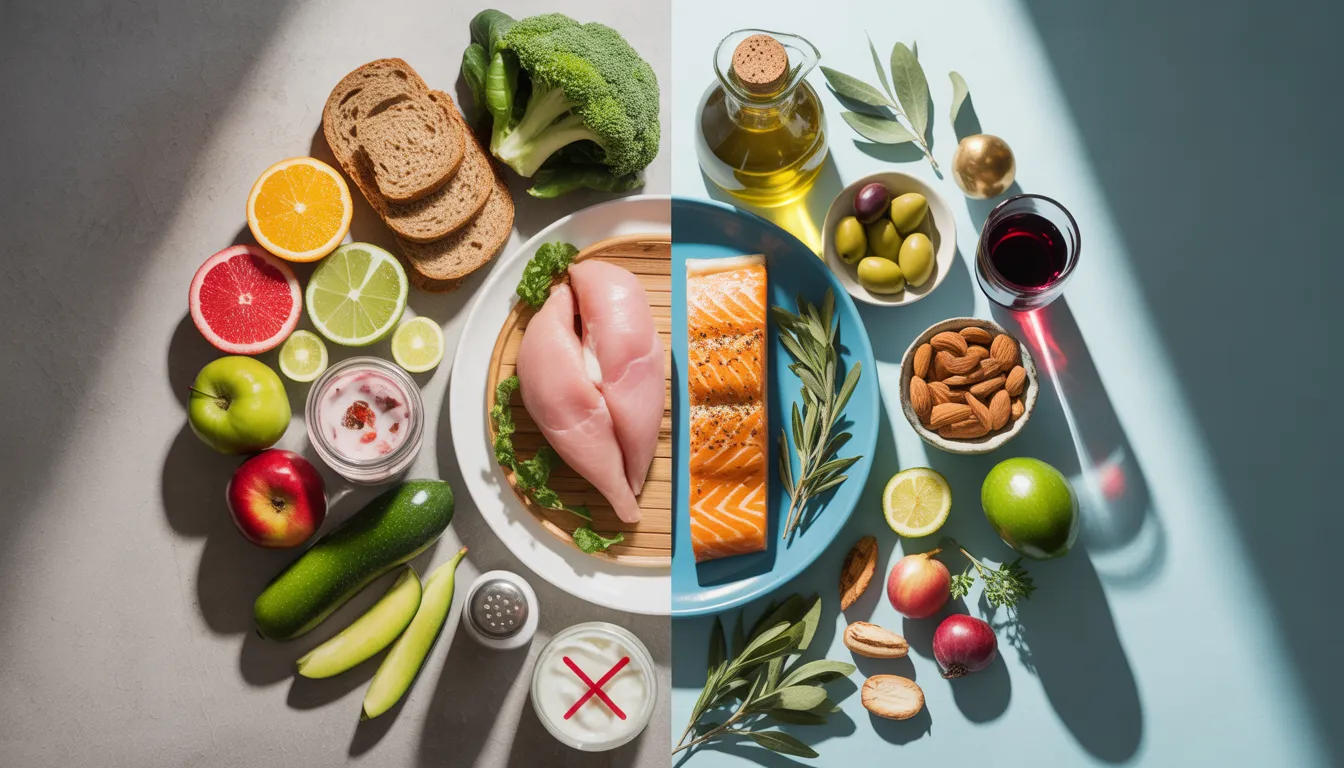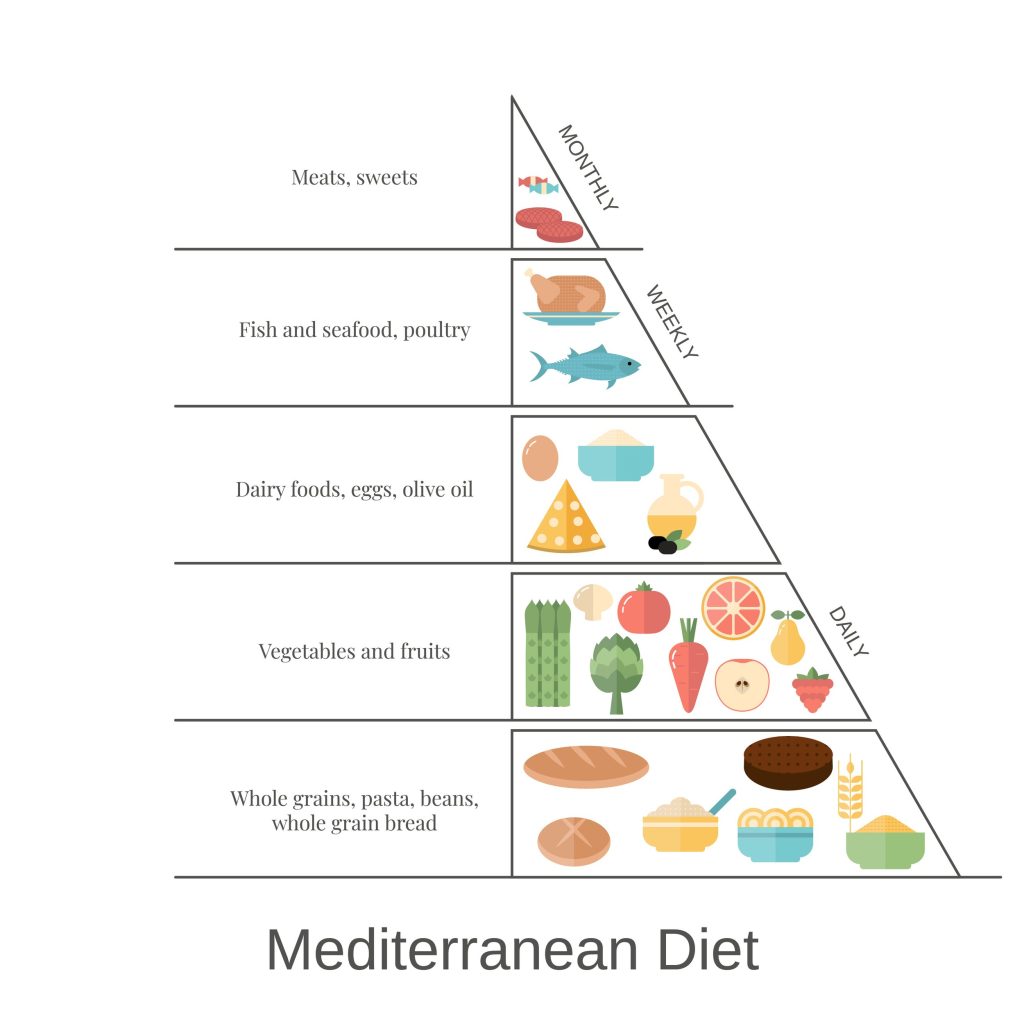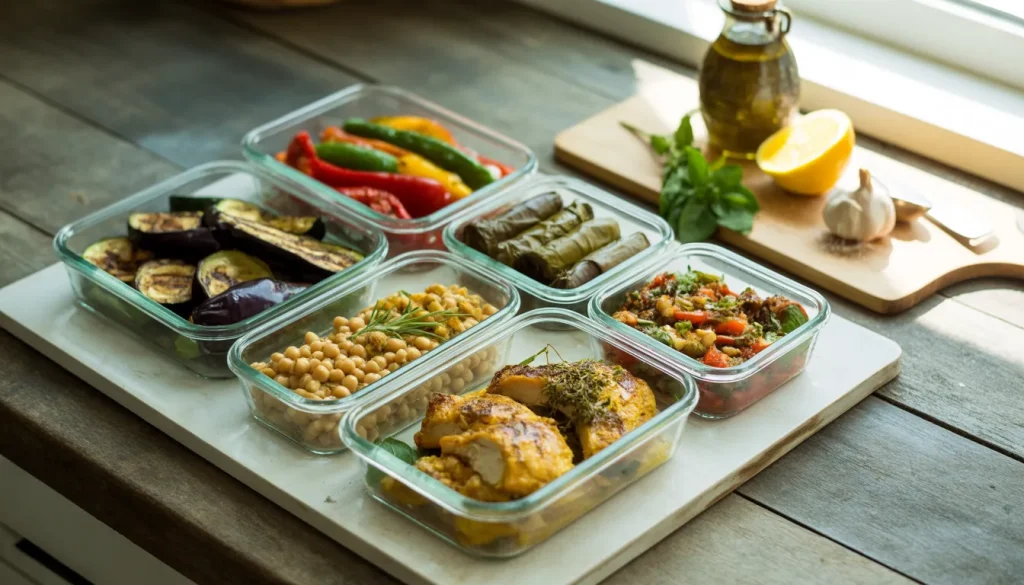
Do you find yourself torn between two of the world’s greatest diets?
The debate over the DASH diet vs Mediterranean diet has intrigued health enthusiasts and physicians alike, leaving people who desire to do the right thing perplexed about the optimal way to live a healthier lifestyle.
Choosing between the DASH and the Mediterranean diets is like deciding between two gold medal winners – both are champions, but one excels at something.
The Mediterranean diet offers a unique approach, focusing on heart-smart fats and lifestyle consumption. With its closely structured nutritional guidelines, the DASH diet targets blood pressure reduction uniquely.
Whether your goal is to manage hypertension, achieve healthy weight loss, or maximize heart health, understanding these special selling points will allow you to align your diet with your objective and lifestyle.
Takeaways
DASH Diet vs Mediterranean Diet Origins
When I first delved into the world of different eating plans, I was surprised to learn that the DASH and Mediterranean diets have vastly different origins.
Their unique development processes show why they work so differently for people.
The DASH Diet: Born in a Lab
The DASH diet didn’t evolve naturally like most eating patterns(1).
In the 1990s, researchers, frustrated with skyrocketing blood pressure rates, decided to take a scientific approach. They designed this diet in clinical trials, testing specific combinations of foods to see what would drop those numbers fastest.
This scientific rigor is a testament to the effectiveness of the DASH diet.
The name says it all: Dietary Approaches to Stop Hypertension.
These weren’t food anthropologists studying ancient cultures; they were scientists in white coats trying to solve a specific medical problem.
And honestly, it shows in how structured and precise the DASH guidelines are.
READ MORE: Understanding Nutrition Basics: How to Fuel Your Body Right
Mediterranean: Accidentally Discovered Longevity
The Mediterranean diet, in contrast, was not a deliberate creation. It was almost accidentally discovered(2).
Researchers, while studying the longevity of people in Greece and Southern Italy, stumbled upon a diet that was not designed but naturally evolved over generations.
They weren’t trying to create a diet – they were documenting what these populations had been eating for generations.
This is where it gets interesting. At the same time, DASH researchers ran controlled trials with measured portions, and Mediterranean diet researchers were doing epidemiological studies, following large groups of people over decades to see what naturally worked.
Expert Insight: “The philosophical difference is huge. DASH asks, ‘What specific foods can we prescribe to fix blood pressure?’ Mediterranean asks, ‘What lifestyle patterns help people thrive naturally?’ Both work, but they’re solving different puzzles.” – Registered dietitian Sarah Chen.
That fundamental difference in origins explains why one feels more like following a doctor’s orders while the other feels more like… well, living.
Core Dietary Principles: How They Actually Work
Understanding how these two diets function daily changed my perspective on eating plans.
One feels like precision medicine, and the other thinks like rediscovering how food was meant to be enjoyed.
READ MORE: How to Integrate Healthy Eating Habits in Real Life
DASH Diet Framework
DASH operates like having a nutritionist plan your meals down to the last serving.
Initially, the structure was overwhelming, but I quickly realized that precision is precisely why it works well for blood pressure management.
Your daily plate becomes a carefully orchestrated balance:
- 6-8 servings of grains (1 slice of bread = 1 serving)
- 4-5 servings of vegetables
- 4-5 servings of fruit
- 2-3 servings of low-fat dairy
- 6 ounces or less of lean meat
The sodium restriction hits hardest. You’re targeting 2,300mg daily, ideally 1,500mg if possible. That’s roughly one teaspoon of salt for your entire day, including what’s already lurking in packaged foods.
The magic happens through specific nutrients that naturally counter high blood pressure:
- Potassium: Bananas, sweet potatoes, spinach, beans
- Magnesium: Nuts, seeds, whole grains, dark chocolate
- Calcium: Low-fat dairy, leafy greens, canned salmon with bones
You can’t just cut salt and call it DASH. The structured portions ensure you get therapeutic levels of these blood-pressure-lowering nutrients – something most people miss entirely.
Mediterranean Diet Structure
Mediterranean food is more about learning to cook from your Italian nonna than following a clinical meal program.
Its sophistication is in its natural flexibility—no measuring or counting, simply tuning in to some foods naturally. This natural and intuitive map for the Mediterranean diet can put you at ease and make you comfortable with what you eat.

Olive oil becomes your primary cooking fat.
We’re talking 3-4 tablespoons daily, which sounds excessive until you realize it’s replacing butter, mayo, and processed oils.
It gets drizzled on vegetables, used for sautéing, and even mixed with herbs for bread dipping.
Fish appears 2-3 times weekly, not because researchers calculated perfect omega-3 doses, but because coastal Mediterranean cultures naturally ate what the sea provided.
The same philosophy applies to moderate wine consumption (1 glass for women, 2 for men)—it’s about the relaxed, social meal experience.
The “fresh, seasonal, minimally processed” approach transforms your grocery shopping mindset. Instead of scrutinizing nutrition labels, you ask, “How close is this to its natural state?”
Portion sizes aren’t dictated by charts or measuring cups. You eat until satisfied, trusting your body’s hunger and fullness cues – a concept that takes time to redevelop after years of external portion control.
READ MORE: Mediterranean Diet vs Carnivore Diet: Which Is Better for You?
Health Benefits Comparison: What Science Shows
When choosing between eating plans, the research tells a compelling story about what each diet delivers.
The data reveals surprising differences in how DASH and Mediterranean approaches affect your health markers.
Blood Pressure: DASH Takes the Lead
DASH was engineered explicitly for blood pressure control, and the numbers prove it works(3).
Clinical trials consistently show systolic blood pressure drops of 6-11 mmHg within 8-14 weeks of following the protocol.
Mediterranean diet studies show more modest blood pressure improvements, typically 2-5 mmHg reductions(4).
That difference matters more than you think. A 10 mmHg drop in systolic pressure translates to roughly 20% lower stroke risk and 15% lower heart attack risk.
The DASH advantage comes from its targeted approach to sodium restriction combined with specific potassium, magnesium, and calcium intake levels.
Mediterranean diets improve blood pressure through different mechanisms, primarily through the anti-inflammatory effects of olive oil and omega-3 fatty acids.
Weight Loss: Different Approaches, Different Results
DASH typically produces faster initial weight loss, averaging 1-2 pounds per week in the first month.
The structured portions and lower sodium intake contribute to rapid water weight loss, followed by steady fat loss from the calorie-controlled framework.
Mediterranean diet weight loss happens more gradually—usually 0.5-1 pound per week.
However, the sustainability factor changes everything. Studies show Mediterranean dieters maintain weight loss longer term because their flexible, satisfying nature prevents the restriction-binge cycle.
This long-term health benefit can make you feel optimistic about your dietary journey.
Clinical Trial Spotlight: PREDIMED-Plus is a large, multicenter, randomized clinical trial involving 6,874 adults aged 55–75 years (men) or 60–75 years (women) with metabolic syndrome and a BMI ≥27 to <40 kg/m². The trial is designed to last six years, with some early analyses reported after one or two years of follow-up(5)
READ MORE: Losing Weight on Carnivore Diet: Expert Solutions Revealed
Cholesterol: Two Different Victories
DASH excels at lowering LDL (“bad”) cholesterol by 10-15% within 8 weeks.
Combining increased fiber, reduced saturated fat, and specific nutrient ratios creates an environment where your liver naturally produces less cholesterol.
Mediterranean diet’s cholesterol story focuses on HDL (“good”) cholesterol increases of 8-12%.
The monounsaturated fats from olive oil and omega-3s from fish create a more favorable overall cholesterol profile, even when total cholesterol doesn’t drop dramatically.
READ MORE: How to Lower Cholesterol on Carnivore Diet Safely
Disease Prevention: Mediterranean’s Long-Term Advantage
Here’s where Mediterranean diet research becomes compelling.
The landmark studies show a 30% reduction in major cardiovascular events—heart attacks, strokes, and cardiovascular deaths—compared to low-fat diet controls.
DASH studies focus more on individual risk factors than long-term disease outcomes.
While blood pressure improvements certainly reduce cardiovascular risk, we don’t have the same decades-long population studies that make Mediterranean evidence so robust.
The Mediterranean advantage likely comes from the synergistic effects of multiple anti-inflammatory compounds working together over time, rather than targeting single health markers.
Daily Implementation: Meal Planning and Costs
The real test of any eating plan comes down to practical implementation – what you’re putting on your plate and how much it costs your household budget.
Both diets require strategic planning, but their daily rhythms feel entirely different.
DASH Daily Structure
DASH meals follow a predictable pattern that makes shopping and meal prep straightforward.
For example, your day might include oatmeal with berries and low-fat milk for breakfast, grilled chicken salad with a whole-grain roll for lunch, and baked salmon with quinoa and steamed broccoli for dinner.
The portions are specific but manageable—half your plate becomes vegetables and fruits, one quarter lean protein, and one quarter whole grains.
To meet those targeted daily servings, snacks center around unsalted nuts, fresh fruit, or low-fat yogurt.
Weekly grocery costs typically run $75-100 for a family of four.
The savings come from emphasizing affordable staples like dried beans, brown rice, and seasonal produce while limiting expensive processed foods.
DASH Budget Staples:
- Dried lentils and black beans ($1-2 per pound)
- Brown rice and quinoa in bulk ($2-3 per pound)
- Frozen vegetables without sauce ($1-2 per bag)
- Chicken breast and lean ground turkey ($4-6 per pound)
- Low-fat Greek yogurt and cottage cheese ($3-4 per container)
- Seasonal fresh fruits and vegetables ($2-4 per pound)
Mediterranean Daily Flow
Mediterranean meals center around olive oil as the flavor foundation.
Breakfast might be Greek yogurt with honey and nuts, lunch could be lentil soup with crusty bread, and dinner features grilled fish with olive oil-roasted vegetables and a glass of wine.
The flexibility means you can adapt meals based on what’s fresh and available.
Portions aren’t measured precisely – you eat until satisfied while prioritizing vegetables, healthy fats, and moderate amounts of high-quality protein.
Weekly costs run higher at $90-120 for a family of four. The premium comes from quality olive oil, regular fish purchases, and nuts as daily snacks rather than occasional treats.
Mediterranean Investment Items:
- Extra virgin olive oil ($12-18 per liter)
- Wild-caught fish fillets ($8-15 per pound)
- Mixed nuts and seeds ($6-10 per pound)
- Fresh herbs and seasonal vegetables ($3-6 per pound)
- Whole grain bread from the bakery ($4-6 per loaf)
- Quality aged cheeses ($8-12 per pound)
READ MORE: How to Eat Healthy Food on a Budget
Shopping and Budget Tips
Batch cooking transforms both approaches from daily stress into a weekly routine.
Sunday meal prep sessions let you portion DASH servings or prepare Mediterranean-based ingredients like roasted vegetables and cooked grains.

Bulk buying works differently for each diet.
DASH benefits from warehouse store purchases of frozen vegetables, lean proteins, and whole grains.
Mediterranean shopping focuses on finding quality olive oil in larger containers and buying nuts in bulk.
The most effective cost control strategy involves seasonal flexibility. Summer tomatoes and winter squash cost significantly less when purchased in season, and both diets adapt easily to what’s abundant and affordable.
Meal Prep Game-Changers: Cook grains in large batches and freeze in portion-sized containers. Pre-cut vegetables on shopping day.
For DASH, portion snacks into grab-and-go containers. For the Mediterranean, prepare herb-infused olive oils that transform simple ingredients into flavorful meals throughout the week.
Making Your Decision: Which Diet Fits Your Life
After examining the research and practical realities, your decision comes down to matching a diet’s strengths with your specific health goals and lifestyle preferences.
Neither approach is universally superior – they excel in different areas.
Choose DASH When Structure Serves You
DASH makes sense if you’re dealing with high blood pressure and need measurable results quickly.
The structured portions and specific guidelines work well for people who thrive with clear boundaries and defined expectations.
Budget-conscious families often find DASH more sustainable in the long term.
The emphasis on affordable whole foods like beans, grains, and seasonal produce keeps grocery costs predictable while delivering significant health benefits.
You’ll also appreciate DASH if you prefer straightforward meal planning without extensive culinary experimentation.
The framework removes guesswork while ensuring balanced nutrition across all food groups.
Choose Mediterranean for Lifestyle Integration
The Mediterranean way of eating is perfect for people who want flexibility without rules.
Suppose you enjoy cooking, experimenting with flavorings, and view meals as social events rather than pit stops to refuel.
In that case, this approach naturally fits your personality.
The anti-inflammatory nature of the Mediterranean makes it particularly appropriate for chronic disease conditions like arthritis, diabetes, or heart disease, where inflammation plays a central role.
Long-term prevention of disease investigation is also broader.
Choose this path if you’re willing to invest more in quality ingredients like good olive oil and fresh fish, viewing food as medicine and pleasure rather than just a nutritional necessity.
The Hybrid Approach
Many people successfully combine elements from both diets.
For example, you might follow DASH’s portion structure while incorporating Mediterranean’s emphasis on olive oil and flexible meal timing.
You could also use DASH guidelines during weekdays with Mediterranean-style weekend meals.
The key is to maintain consistency with whichever elements you choose.
Sporadic adherence to either approach delivers minimal benefits compared to steady, long-term implementation.
Your Personal Assessment Framework
Consider your current health status first. Active hypertension or pre-diabetes might push you toward DASH’s more immediate results.
General health maintenance and prevention favor the Mediterranean lifestyle approach.
Evaluate your cooking skills and time availability honestly.
DASH requires less culinary expertise but more precise planning.
Mediterranean cuisine demands comfort with cooking techniques but offers more spontaneous meal options.
Diet Selection Checklist:
✓ Primary health concern (blood pressure vs. general wellness)
✓ Budget constraints and grocery priorities
✓ Cooking confidence and time availability
✓ Preference for structure vs. flexibility
✓ Family dynamics and meal-sharing requirements
✓ Long-term sustainability given your lifestyle
Your successful choice isn’t about picking the “best” diet but the approach you can consistently maintain while achieving your specific health objectives.
FAQ
Can You Combine DASH and Mediterranean Diet Principles?
Absolutely! Many nutrition experts recommend blending elements from both diets. For example, you can adopt the Mediterranean diet’s emphasis on olive oil and fish while incorporating DASH’s sodium restrictions and specific serving recommendations. This hybrid approach often provides the best of both worlds for comprehensive health benefits.
Which Diet Is Better for High Blood Pressure?
The DASH diet was explicitly designed to lower blood pressure and typically shows faster results for hypertension management. However, the Mediterranean diet also effectively reduces blood pressure over time, particularly due to its anti-inflammatory properties and heart-healthy fats.
Are These Diets Suitable for Vegetarians?
Both diets easily accommodate vegetarian lifestyles. The Mediterranean diet naturally includes plenty of plant-based proteins. In contrast, DASH diet guidelines include vegetarian protein sources like beans, nuts, and seeds as core components.
How Quickly Can I Expect to See Results?
DASH diet participants often notice blood pressure improvements within 2-4 weeks, while Mediterranean diet benefits may take 6-8 weeks to become apparent. Weight loss typically occurs gradually with both approaches, averaging 1-2 pounds per week when combined with appropriate calorie control.
Which Diet Is More Budget-Friendly?
The DASH diet tends to be more budget-conscious, emphasizing affordable staples like whole grains, beans, and seasonal vegetables. The Mediterranean diet can be more expensive due to olive oil, nuts, and fresh fish. Still, innovative shopping strategies can make both diets affordable.
Conclusion
The DASH and Mediterranean diets offer tested and proven mechanisms for good health.
Your choice, though, is based on your goals and your style. Choose DASH if you’re looking primarily to lower blood pressure quickly and prefer strict guidelines.
Choose the Mediterranean diet for a less restrictive, lifestyle-based eating style emphasizing longevity and overall health.
Remember that the best diet is one that you can maintain in the long term.
Choose based on your finances, cooking skills, culture, and health priorities.
Have your needs discussed with a healthcare provider or registered dietitian and create a personalized plan that combines the strengths of both approaches for your unique needs.






